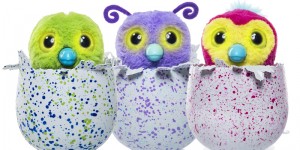Hatchiamals, Cascades, and Endogenous Events
The holiday season is often a time rife with examples of cascades as people turn to the influence of acquaintances and reviewers in deciding what to buy their friends and loved ones. Every once in awhile, however, there is a singular product that sees an explosion in sales around the holidays and creates a notable cascade in a matter of mere weeks. There is such an item this year—Hatchimals. As The NDP Group’s U.S. toy industry analyst Juli Lennett is quoted as saying on CNBC, “for the last four years, there has been nothing comparable to the instant sales success within weeks of launch as Hatchimals.”
Networks can provide us a more detailed look into why technologies like Hatchimals are adopted and diffuse through networks. Clearly a cascade has been set off for Hatchimals, with kids around the country demanding them and parents lining up for hours to find them. It is also clear that, if the threshold rule holds, many peoples’ thresholds are being surpassed since so many people are eager to adopt the product. As such, we can assume that friend groups or other social networks—such as schools—are playing a big role in the product’s spread (i.e. a large majority of a kid’s classmates have them or are asking for them for the holidays, making them want one too) or that the threshold for adopting Hatchimals is fairly low.

An array of Hatchimals. Source: “Everything You Need to Know About Hatchimals”, Yayomg.com, https://www.yayomg.com/hatchimals-spin-master/
We know, too, that companies looking to start a cascade for their product will target certain demographics with advertising, hoping that the product will spread. Excessive advertising for toys is a staple of the holiday season, of course, and we can expect advertising on children’s television networks to be playing a role in the this year’s Hatchimal craze. Such advertising leads to common knowledge about whatever product is being peddled and gives off the impression that people are using said product. The Hatchimals commercials, which show groups of kids excitedly opening up the toy during the holidays, surely gives kids the impression that other individuals their age and in their social networks are using the product, which can help them surpass any adoption threshold they may have. This works by giving them the impression that whatever threshold they may have for adopting the new product (or, in this case, asking for it) has been surpassed since—with lots of advertising showing large groups of kids using the product—the required amount of known people using the product and more are using/asking for a Hatchimal.
Furthermore, the mass shortages of Hatchimals has created a market with qualities like those we’ve studied. Since there are more buyers than sellers, the toys are being sold on auction sites like eBay at the upper limits of the Hatchimal price range. Some individuals, too, bought Hatchimals in the weeks leading up to the holiday rush expecting them to be endogenous, and that there would be an aggregate demand for the toy. Surely many others who were not looking to make money off of selling the toy at a later date, but who had a child they planned to buy a toy for for the holidays, caught wind of the uptick in demand for Hatchimals and bought one thinking soon it would be too late. As such, the Hatchimal—like many must-have holiday toys before it—was subject to a self-fulfilling expectations about its holiday success and eventual difficulty to locate. As a result, Hatchimals, with variants like the Bearakeet and Owlicorn, is one of the hottest items of the last few years.
